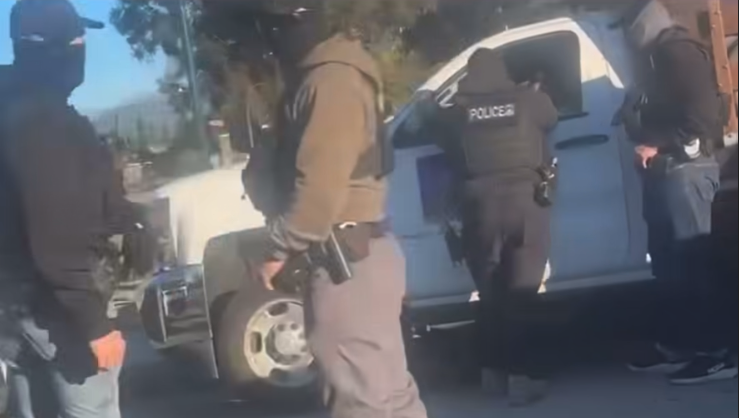In mid-February, writer-director Alex Cox announced that he’s planning to follow up his 1984 cult flick Repo Man with an official sequel: Repo Man 2: The Wages of Beer.
Cox recently told IndieWire that the film will see the return of his main protagonist, Otto, who Emilio Estevez originally played, and the story will focus on the Internet and other modern-day technology. A new actor, Kiowa Gordon, is slated to play Otto, considering the character has aged only 90 minutes during his 40 years of interstellar travel.
“Repo Man 2: The Wages of Beer takes place in a world of driverless cars, and the repo man never leaves the office,” Cox told L.A. TACO via email.
Naturally, we were interested in learning from Cox if Otto will be returning to Los Angeles, which plays an integral supporting role in the original film, and, if so, how much of contemporary L.A. will be seen in the sequel.
“It [the setting] is quite claustrophobic,” Cox added, “and L.A. is really seen only through windshields and grimy windows.”
When asked if he was planning to shoot the sequel in L.A. and when he was hoping production might start, Cox did not elaborate further.
The original film somehow managed to cohesively fuse weathered, jaded repo men, L.A.’s burgeoning punk scene, UFO cultists, generically-labeled food items, and nuclear proliferation into a dark comedy that is both a product of its time and yet feels somewhat timeless.
Otto, a self-described white suburban punk, quits a mind-numbing job as a grocery store stockboy, loses his girlfriend to an old buddy who’s just out of prison, and is neglected by his televangelist-consumed parents. He finds, well, not exactly solace, but some sort of acceptance within a motley group of repo men after he stumbles across the path of Bud, a leathery trade veteran played to curmudgeonly perfection by the late Harry Dean Stanton. Bud teaches Otto the ins and outs of repossessing defaulted vehicles, a job that Cox once himself dabbled in for about three months.
When Bud and the team learn of a 1964 Chevy Malibu that’s wanted for an astonishing $20,000 bounty, they race against their rivals, the Rodriguez Brothers, to track down the car. Unbeknownst to any of them, the Malibu holds a glowing secret with the incredible power to vaporize anyone who dares to open the trunk.

Early screenplay versions were part road movie and part L.A. movie, but that changed in later drafts.
“It seemed fiscally and narratively sensible to concentrate the story in L.A.,” Cox said in L.A. TACO's email correspondence.
The film’s co-art director, L.A. native Lynda Burbank, told us via email, “I think, personally, Alex realized that L.A. was the perfect spot for Repo Man because our culture was always based on freeways and suburbs and car travel.”
Cox had lived in L.A. for five years when he wrote Repo Man, having first come to town from the UK to study film at UCLA.
“One of the best things about Alex was he was a Brit coming to L.A.,” said Burbank, “and he noticed and loved many things about the city.”
“I was very impressed by the freeway system and the architecture and the bridges downtown,” said Cox. “I went down there often. We shot our student film’s down there and went to punk rock shows at Al’s Bar and other venues.”
Cox added, “It would have been nice to live downtown, but the air quality in the those days was very bad.”
Repo Man was shot in July and August of 1983.
“In the summer, the air quality was always the worst. So, in daytime, the heat definitely was there—you can see it on the actors in the cars,” Cox told us.
Much of Repo Man is set in downtown L.A. and was shot in and around the Arts District. Cox said he set the film there “because of its incredible visual aspect.”
Many of the downtown driving images that Cox and the legendary, late cinematographer Robby Müller captured depict a textured but desolate, sodium vapor-lit urban hellscape—unsettling images for sure when compared to the perpetual development and redevelopment of contemporary downtown L.A.
“All the street exteriors seen through the windshields [in the film] are real,” said Cox, who doubts he’d be able to capture similar imagery with the same freedom today. “I imagine there’d be a lot more permitting and policing. We just went for it a lot of the time. But this was 40 years ago, in the middle of the night. There was a lot less traffic.”
Many of the downtown driving shots were filmed as pickups during post-production.
The film’s production sound mixer and Cox’s film school peer Steve Nelson told us in an email, “We shot 36 locations in 32 days, all on location. We were a busy little show.”
Repo Man was an independent feature green-lit by Universal Pictures—largely thanks to the film’s executive producer, ex-Monkees guitarist Michael Nesmith—in a negative pickup deal. In short, the studio would purchase the movie upon completion and distribute it.
The film’s estimated budget was $1.5 million.
Though downtown plays a central character in Repo Man, locations spanned the L.A. region.
A stretch of East Avenue T in Palmdale—doubling Route 66 near the Mojave Desert town of Goffs, CA—is seen in the film’s opening sequence, during which a suspicious highway patrol officer is vaporized upon inspecting the Malibu’s trunk; a bungalow home next to the Phillips 66 oil refinery in Wilmington is the site of a repossession-turned-gunfight; a TV studio at UCLA doubles for the high-tech interior of a government surveillance truck.

A few of the film's locations are just flat-out gone today.
Long extinct is the site of Otto’s first official repo, a 1976 Cadillac Eldorado belonging to a brokerage consultant. “Fuckin’ millionaires, they never pay their bills,” Bud says disconcertedly to Otto. The laundromat where Otto successfully lifts the car sat on the site of what is now the Hollywest Promenade shopping center at Hollywood Blvd and Western Ave.
The Helping Hand Acceptance Corporation site, the repo company where Otto works, was also redeveloped about ten years after the film was made.
“This location was a large, empty lot surrounded by a chain link fence,” said Burbank.
The main office was constructed; weeds were planted; exterior elements were aged. The address on the building, 2100 Wall St, would place it south of the 10 freeway. But signage on adjacent buildings seen in the film puts the lot at about 1015 Crocker St. Today that address is part of the San Pedro Wholesale Mart in the Fashion District.

Repo Man—arguably one of Cox’s best-known films alongside 1986’s Sid and Nancy—played to well-received notices at the Berlin Film Festival. Still, it made little money after its initial release on March 2, 1984, due to a lackluster rollout by Universal Pictures after a regime change at the studio. Box Office Mojo estimates initial domestic office receipts at $129,000; In his book, X Films: True Confessions of a Radical Filmmaker, Cox estimates the box office take to be a little more. Bottom line: it wasn’t a moneymaker.
The film later gained notoriety and a cult following largely due to its punk-packed soundtrack that featured Iggy Pop and L.A. bands like Circle Jerks, Black Flag, Fear, Suicidal Tendencies, and The Plugz. Home video, of course, helped spread the Repo Man gospel, too.
To mark the film’s 40th anniversary, here are ten locations from Cox’s Reagan-era, punk-sci-fi L.A. indie that are still largely unchanged.
Otto’s Neighborhood
After Otto quits his job at the supermarket, loses his girlfriend Debbie (Jennifer Balgobin) to his best friend Duke (Dick Rude), and contemplates his next career moves, he returns to his home on, literally, the other side of the tracks.
Adding to the film’s timeless quality, a 1953 TDH-4512 “Old Look” transit coach with the destination of Edge City posted on front approaches on a long stretch of road. (Edge City, aka Sleep Is for Sissies, is the title of Cox’s 1980 short film and was the name of his production company.) As the sun rises, a group of kids and teenagers board the bus while Otto pushes his way past them. The camera pans with Otto as he crosses the street towards a suburban neighborhood. A quick glimpse of street sign reflecting the light of the rising sun reads San Fernando Road.
It’s one of the film’s few Valley locations, shot along San Fernando Road near the north side of the Burbank Airport in Sun Valley. However, co-art director Burbank said Otto’s house interior was shot in Studio City.
San Fernando Rd & Ledge Ave, Sun Valley

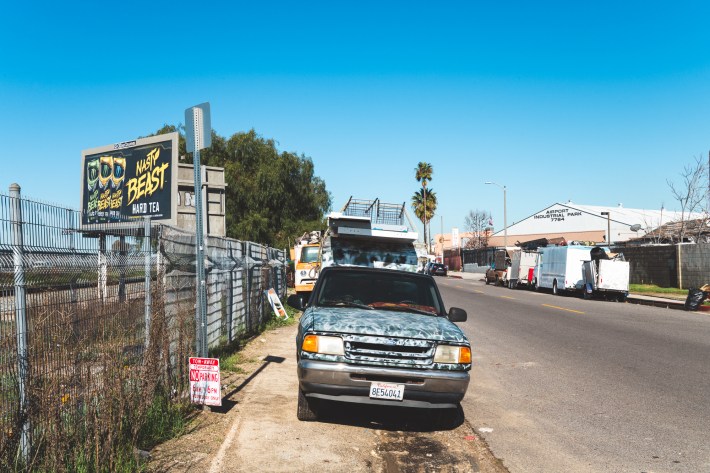


United Fruitcake Outlet
While cruising along 23rd Street just off San Pedro Street, Otto notices a young woman with flowing brown hair running along the sidewalk. Distracted as a result of trying to pick her up, Otto plows into some trashcans on the corner of 23rd St and Stanford Ave. The young woman, Leila (Olivia Brash), eventually accepts a ride and gets into the aforementioned red convertible Eldorado from the laundromat.
When two government agents pull up next to the Eldorado, Leila quickly ducks to the floor. She hands Otto a black and white infrared photograph of some indiscernible organic objects. She informs Otto that it’s a picture of four dead extraterrestrials, that she’s a member of a secret network of alien enthusiasts, and there’s a scientist driving around with the deceased remains of the otherworldly beings in the trunk of a Chevy Malibu.
Otto drops off Leila at the United Fruitcake Outlet, a front for the secret society to which she belongs.
The manufacturing warehouse on the corner of 28th St and Santa Fe Avenue in the City of Vernon was built in 1930.
2404-2406 E 28th Street, Vernon


Ripping the Firebird
Otto and fellow repo man Lite (Sy Richardson) cross a cracked blacktop with the remnants of street car tracks running down the center. Lite informs Otto that they’ve long been after the red 1970 Pontiac Firebird that sits unattended along the curb. They slim Jim the lock, and as the car alarm sounds, Lite calmly uses the tools in his black briefcase to successfully start the car. They peel off towards downtown.
Incidentally, the same stretch of Banning Street on the border of Little Tokyo and the Arts District was used in the final scene of David Lynch’s Wild at Heart (1990), in which a snakeskin jacket-clad Nicolas Cage sings “Love Me Tender” to Laura Dern while standing on the hood of Datsun B210 convertible.
721 Banning Street., Little Tokyo


The All-Night Coffee Shop
After the Rodriguez Brothers - Lagarto (Del Zamora) and Napoleon (Eddie Velez)—steal the pivotal Chevy Malibu donning New Mexico plates, they pull over at an all-night coffee shop when they can no longer stand the intense heat emanating from the vehicle’s trunk.
While Lagarto makes a call at a payphone and Napoleon orders a couple of drinks, Debbie, Duke, and their mohawk-sporting associate, Archie (Miguel Sandoval), come running along after robbing a nearby pharmaceutical company and make a getaway in Malibu.
772 Maple Avenue, Fashion District




Fox & Mac Taggart Pharmaceutical Company
While Napoleon and Lagarto are making their pitstop at the coffee shop, Debbie and Duke are in the midst of robbing a pharmaceutical company. When Archie fails to catch the brown paper bags that are tossed to him from a fire escape, red, yellow, and white pills spill out all over the sidewalk. The three punks make a run for it through a sordid alleyway.
The scene was filmed around the corner from the coffee shop at the north end of Santee St, which dead ends into Santee Passage. The wide pedestrian alley, formed by residential and commercial spaces to each side, connects Santee Street to Los Angeles Street.
701 Santee Street, Fashion District

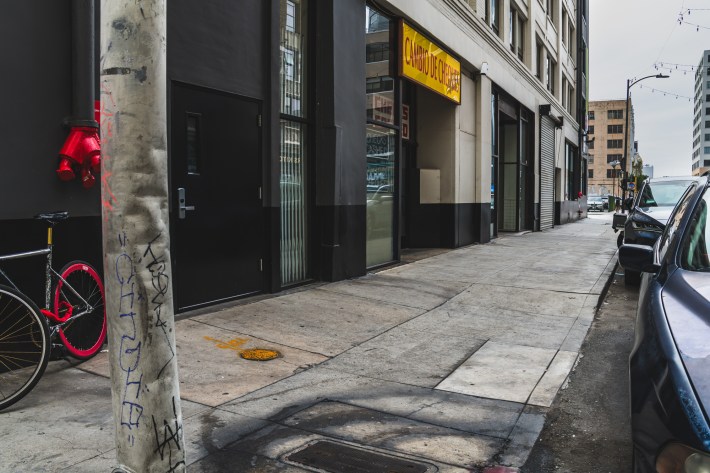


Santee Passage
Leila and J. Frank Parnell (Fox Harris), the eccentric scientist driving around in the Chevy Malibu, speaks to each other via phone booths on two opposite corners of a street intersection. Just then, a 1971 AMC Matador speeds toward Parnell. The scientist barely escapes his death as the car obliterates the phone booth.
In looking at the film, the Streamline Moderne brick building against which Leila’s phone booth rests appears as though it was unoccupied at the time. Through the 1970s, the building was home to G&G Produce Co. Today it is Panda Produce, which specializes in the distribution of Asian vegetables. On any given day, people can be seen just down the block near Mateo St taking photos in front of the Nipsey Hussle mural, “Hussle & Motivate,” painted in 2021 by Misteralek, BigAnti26 and HUFR.
Violet St & Wilson St, Arts District




Repo Men Standoff
When the Rodriguez brothers encounter Parnell driving the Chevy Malibu along 4th St just off the 110 freeway, they pursue - posing as “special deputies” — in hopes of reacquiring the valuable vehicle. When Bud and his crew happen along, they decide to settle a score with the competition and chase the brothers into the Lower Grand Concourse.
The concrete, futurist aesthetic of Lower Grand has been a favorite of filmmakers for decades, having also appeared in action movies like The Terminator (1984), Cobra (1986), Tony Scott’s Beverly Hills Cop II (1987), and The Last Boy Scout (1991), Batman Forever (1995), The Replacement Killers (1998) and The Italian Job (2003).
4th St & Lower Grand Ave, Downtown


Spotting the Malibu and Burning a Body
While walking down a garbage-strewn sidewalk, Otto observes men in hazmat suits picking up the body of a dead man and loading him into the back of a white truck that’s much like the government surveillance vehicle we’ve seen throughout the film. When Otto reaches the end of the block, he spies the Malibu, sharply turning the corner.
After overexerting to catch up with the car and subsequently hitching a ride with Parnell, Otto comes to believe that what’s emitting heat from the trunk is actually a neutron bomb. When Parnell passes out and dies at the wheel, Otto pulls his body out of the car and puts it on a bus stop bench. Later that night, government agents discover Parnell’s body and incinerate it with a blowtorch.
All of this action happens around the intersection of Mateo Street and Palmetto Street and in front of the Nate Starkman Building, a 1908 brick factory that’s been featured in films like Rising Sun (1993), National Treasure (2004), Date Night (2010) and National Lampoon’s Loaded Weapon 1 (1993) in which Estevez also stars.
Mateo St & Palmetto Street, Arts District





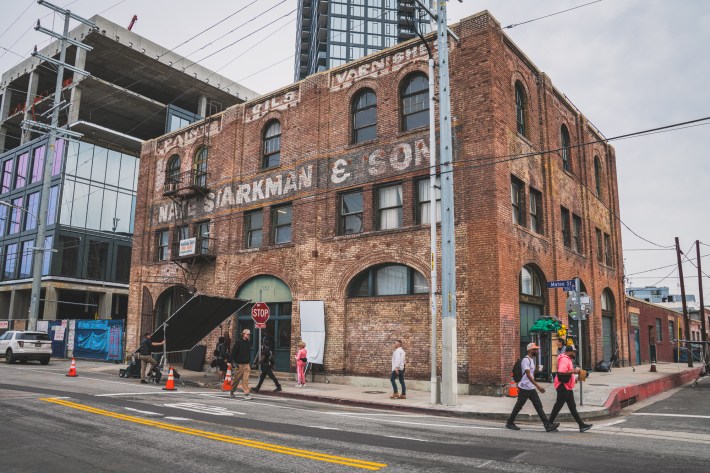
Chasing Down the Malibu
When Otto spots the Malibu at Mateo and Palmetto, he chases it onto the 4th Street Bridge, eventually losing track of it. Then Otto spots the car passing under the bridge. Racing to catch up, Otto descends the stairs that lead from the bridge to Santa Fe Ave. Upon rounding the corner, the Malibu skids to a stop. The passenger door springs open, and Otto gets in. As the Malibu continues and exits the frame, we’re left with a static shot of the bridge’s overpass along Santa Fe Avenue.
4th St Bridge and Santa Fe Ave, Arts District
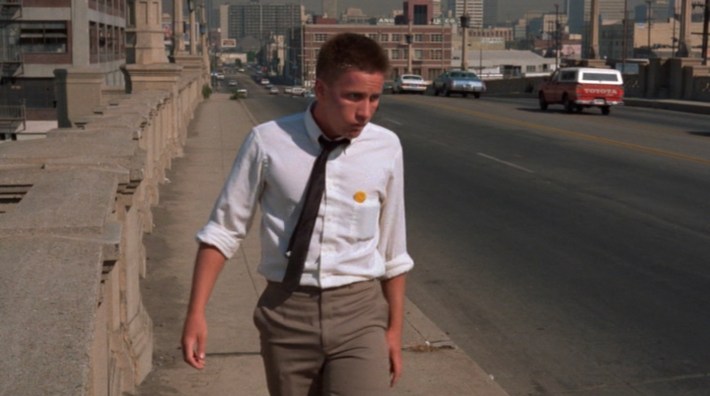


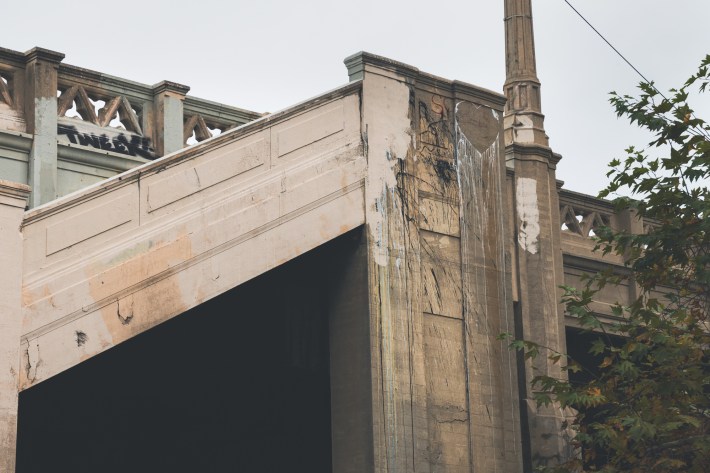


Liquor Store Shootout
When Debbie and Duke burst into a liquor store they intend to rob, pistol and double-barreled shotgun in-hand, they inadvertently cross paths with Otto and Bud. Debbie orders them up against the wall. As Duke threatens Otto with his shotgun, Bud reaches for the handgun in his waistband. Just then, a security guard (Luis Contreras) from the grocery store where Otto used to work - who happens to be shopping at the liquor store - pulls out his sidearm. A Mexican standoff ensues.
Only the word liquor adorns the front of the store, but the address on the building, 7137, places the location at Lindley Liquor near the corner of Lindley Ave and Sherman Way in Reseda. The store has changed very little from how it appeared in Repo Man.
7137 Lindley Avenue, Reseda


Photo by Jared Cowan for L.A. TACO
Follow Jared on Instagram at jaredcowan.

